Centauri Dreams
Imagining and Planning Interstellar Exploration
Runaway Stars in Orion
Unexpected things can happen when you’re looking for exoplanets. Ask Kevin Luhman (Penn State), whose search for free-floating planets in the Orion Nebula is now telling us something interesting about star formation in general. In a small region dominated by young stars called the Kleinmann-Low Nebula, some 1300 light years from Earth near the center of the Orion Nebula complex, Luhman and team have come across evidence of a multiple star system whose members have flown rapidly apart due to gravitational interactions with their peers.
Luhman’s team was using the Hubble instrument’s Wide Field Camera 3 to run the planet-hunting survey, working with Massimo Robberto (Space Telescope Science Institute) and a group of international colleagues. A star referenced only as ‘source x’ turned up in a comparison between 2015 imagery in the infrared and infrared observations made in 1998 with the Hubble telescope’s Near Infrared Camera and Multi-Object Spectrometer. The surprise: ‘Source x’ had changed its position substantially in those 17 years.
Working out the star’s velocity, the team concluded that it was moving at about 210,000 kilometers per hour. Moving backwards in time, the researchers could chart the star’s travels, and found that in the 15th Century AD, ‘source x’ had been in the same location in the Kleinmann-Low Nebula as two other runaway stars, known as Becklin-Neugebauer (BN) and “source I,” that are now traveling in opposite directions from each other. Discovered in the infrared in 1967, BN has been found to be moving at 95,000 kilometers per hour, while ‘source I’ is clocked at 35,000 kilometers per hour, deeply shrouded in dust and previously observed only through radio telescope studies.
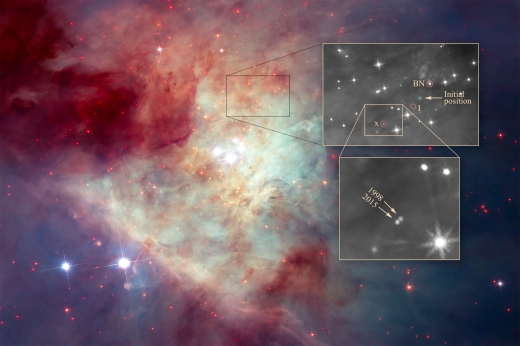
Image: This dramatic view of the center of the Orion Nebula reveals the home of three speedy, wayward stars that were members of a now-defunct multiple-star system. The stellar grouping broke apart 500 years ago, flinging the three stars out of their birthplace. The box just above the Trapezium Cluster outlines the location of the three stars. A Hubble close-up view of the stars is shown at top right. The birthplace of the multi-star system is marked “initial position.” Two of the stars — labeled BN, for Becklin-Neugebauer, and “I,” for source I — were discovered decades ago. Source I is embedded in thick dust and cannot be seen. The third star, “x,” for source x, was recently discovered to have moved noticeably between 1998 and 2015, as shown in the inset image at bottom right. Source x is traveling at an unusually high speed of 210,000 kilometers per hour, which is 30 times faster than the velocity of most stars in the nebula. Credit: NASA, ESA, K. Luhman (Penn State University), and M. Robberto (STScI).
“The new Hubble observations provide very strong evidence that the three stars were ejected from a multiple-star system,” says Luhman. “Astronomers had previously found a few other examples of fast-moving stars that trace back to multiple-star systems, and therefore were likely ejected. But these three stars are the youngest examples of such ejected stars. They’re probably only a few hundred thousand years old. In fact, based on infrared images, the stars are still young enough to have disks of material leftover from their formation.”
All three of these stars are making their way out of the Kleinmann-Low Nebula at high speed, and they may be representative of what happens in young stellar clusters, where the spacing between infant stars is tight. Luhman’s team believes the Orion Nebula could have spawned numerous such interactions, with young stars being ejected from it in great numbers. As to the process at work, it probably results from two members of a multiple star system forming a tight binary or even merging, releasing enough gravitational energy to push all the stars in the system outward and creating a powerful outflow of material. And this bit from the paper on this work is interesting:
Some aspects of the interaction that ejected BN and sources I and x remain unclear, such as how these stars were able to retain or reform their circumstellar disks (Goddi et al. 2011; Plambeck & Wright 2017) and the source of their current kinetic energy… [T]he latter has been previously attributed to the gravitational potential energy released by a pair of stars forming a tight binary or merging, likely in what is now source I. The energy produced by the merger of stars with a total mass of source I (e.g., 1 and 6 M?) is an order of magnitude greater than the kinetic energy of the three stars, so that remains a plausible explanation.
Note that comment about circumstellar disks — how could stars undergoing this kind of gravitational upheaval maintain their disks? The paper’s earlier reference to the problem seems understated, and references another star, ‘source n,’ explained below: “It is challenging to explain the presence of the circumstellar disks around BN and sources I and n if they experienced interactions that were sufficiently close to produce the rapid ejection of BN.”
Challenging indeed, and doubtless the subject of further study. Such disks do indeed mark the youth of the stars involved, but we have a lot to learn about how these interactions would affect material around the stars themselves. Reminding us of the complexity of such analysis, the ‘source n’ mentioned above is yet another star with high proper motion, but one which Luhman and colleagues believe did not participate in the events affecting the other three.
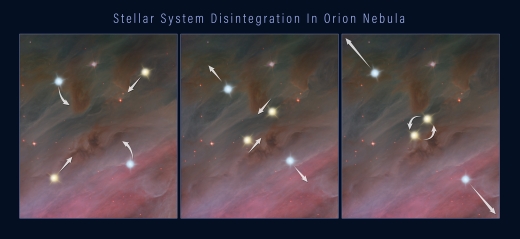
Image: This three-frame illustration shows how a grouping of stars can break apart, flinging the members into space. The first panel shows four members of a multiple-star system orbiting each other. In the second panel, two of the stars move closer together in their orbits. In the third panel, the closely orbiting stars eventually either merge or form a tight binary. This event releases enough gravitational energy to propel all of the stars in the system outward, as shown in the third panel. Credit: NASA, ESA, and Z. Levy (STScI).
It’s not often that we run into stellar phenomena that we can relate to events within our own written history, but here we have a date — 1475 plus or minus 6 years — that takes us back to a time when the Wars of the Roses convulsed England. Somewhere not long before the death of Edward IV, with his brother Richard III waiting in the wings and all hell about to (again) break loose, this distant star system was itself convulsed, its component parts flung into the deep. Finding ‘source x’ and relating it to its fast-moving cousins BN and ‘Source I” answers the puzzle of their motion and reminds us how violent early stellar evolution can be.
The paper is Luhman et al., “New Evidence for the Dynamical Decay of a Multiple System in the Orion Kleinmann-Low Nebula,” Astrophysical Journal Letters Vol. 838, No. 1 (16 March 2017). Abstract / preprint.

Star in Tight Orbit around Black Hole
Beyond their obvious value in advancing our knowledge, astronomical discoveries can be thought of as exercises for the imagination, making us think about what we would see if we were actually near the phenomenon being observed. The view from a planet deep in a globular cluster can only be spectacular, and has been the subject of my own musings for many years. But this morning’s topic, a white dwarf star in a fantastically tight orbit around a black hole, leaves my imagination reeling. Just what would a scenario like the one playing out in the globular cluster 47 Tucanae, some 14,800 light years from Earth, look like up close?
Here we find, thanks to the space-based Chandra X-Ray Observatory and NuSTAR (Nuclear Spectroscopic Telescope Array), as well as the Australia Telescope Compact Array, a binary that consists of an apparent white dwarf orbiting a black hole every 28 minutes. The presence of large amounts of oxygen in the system gives weight to the idea that the companion is indeed a white dwarf, as an abundance of oxygen is a characteristic feature of white dwarfs.
The orbit here is so tight that the star is separated from the apparent black hole by a distance about 2.5 times the separation between the Earth and the Moon.
“This white dwarf is so close to the black hole that material is being pulled away from the star and dumped onto a disk of matter around the black hole before falling in,” says lead author Arash Bahramian (University of Alberta and Michigan State University). “Luckily for this star, we don’t think it will follow this path into oblivion, but instead will stay in orbit.”
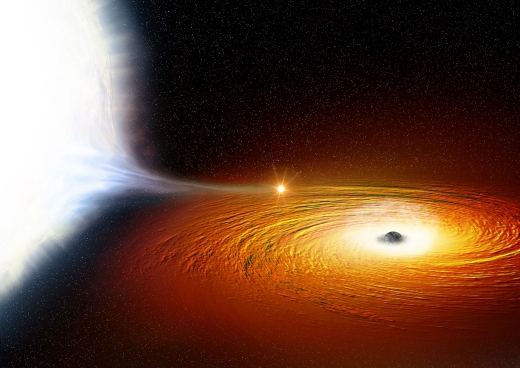
Image: An artist’s impression of a white dwarf star (left) in orbit around a black hole and so close that much of its material is being pulled away. There is a hotspot where the gas from the white dwarf hits the disc of matter swirling around the black hole. The black hole itself is surrounded by a cloud of ionised gas, which contains large amounts of oxygen. Credit: X-ray: NASA/CXC/University of Alberta/A.Bahramian et al.; Illustration: NASA/CXC/M.Weiss.
The orbital determination is made from the changes of brightness observed on a regular 28 minute cycle by Chandra. And the likely outcome of this tight pairing for the white dwarf is that it will eventually become something even more unusual. Says James Miller-Jones (Curtin University, Western Australia and the International Centre for Radio Astronomy Research):
“We think the star may have been losing gas to the black hole for tens of millions of years and by now has now lost the majority of its mass. Over time, we think that the star’s orbit will get wider and wider as even more mass is lost, eventually turning into an exotic object similar to the famous diamond planet discovered a few years ago.”
Small digression: More commonly known as a ‘carbon planet,’ an exotic world like the one Miller-Jones mentions draws on work from Marc Kuchner (NASA GSFC) and Sara Seager (MIT), who investigated the possibility that carbon-rich, oxygen-poor protoplanetary disks might form such planets. Here the visualization exercise gets another workout: Layers of diamond could exist within the mantle, possibly erupting to the surface during volcanic episodes. In addition to mountains of diamond, the surface could contain liquid or frozen tar and methane.
Although 55 Cancri e is frequently cited as a possible carbon planet, pulsar planets have also been suggested as candidates, and in connection with today’s story, it’s worth pointing out that carbon planets are also speculated to be found in globular clusters, where stars have a higher carbon-to-oxygen ratio than the Sun — hence Miller-Jones’ allusion to diamond planets in the quotation above. As to the binary in the globular cluster 47 Tucanae, called X9, the origin scenarios being discussed are intriguing. From the paper:
Low mass X-ray binaries (LMXBs) are systems in which a compact object [neutron star (NS) or black hole (BH)] accretes matter from a low mass companion (typically a main sequence star) through Roche-lobe overflow or wind-fed accretion (from a red giant). It has been long noticed that the population of LMXBs per unit mass in globular clusters (GCs) is orders of magnitude higher than that of the Galactic field… This overabundance has been associated with the high stellar density in GCs. While most LMXBs in the Galactic field are formed through binary evolution of primordial binaries, it has been shown that in GCs, the dominant channel to form LMXBs is through encounters. These scenarios include tidal capture by an NS or BH, exchange of a compact object into a primordial binary, or collision of a compact object with a red giant…
Here too the visualization game stretches the imagination. A black hole encounters a red giant star, with gas from the star being ejected and the remnants of the red giant’s atmosphere becoming a companion to the black hole in the form of a white dwarf. Whether or not we are looking at the result of such an encounter in X9, or whether this is actually a white dwarf paired with a neutron star that is stripping material from its companion, is not entirely clear, though X9 lacks many features of this kind of transitional millisecond pulsar.
“We’re going to watch this binary closely in the future, since we know little about how such an extreme system should behave,” says co-author Vlad Tudor (Curtin University/ICRAR). “We’re also going to keep studying globular clusters in our galaxy to see if more evidence for very tight black hole binaries can be found.”
Before now, the closest star around a likely black hole was the system called MAXI J1659-152, where the orbital period is 2.4 hours, much longer than the 28 minutes we see in X9. There is also evidence for a similar system in the galaxy M49 (about 56 million light years away in the Virgo Cluster). That one is believed to have an orbit even tighter than X9’s, but Miller-Jones points out that there is no direct measurement of its period, making this work on X9 the first time that an orbital period this short in a system containing a likely black hole has ever been measured. An interesting exercise for the imagination indeed.
Although the gravitational waves from this system are too weak to detect with present ground-based observatories, future space-based platforms may be able to detect them.
The paper is Bahramian et al., “The ultracompact nature of the black hole candidate X-ray binary 47 Tuc X9,” Monthly Notices of the Royal Astronomical Society 14 March 2017 (abstract / preprint).

Giant Planet Clues to a Debris Disk Anomaly
A massive young planet on the borderline between gas giant and brown dwarf is telling us a bit more about planet formation in general, and circumstellar disk dynamics in particular. Known as HD 106906b, the world is 11 times the mass of Jupiter and no more than 13 million years old. Its position 650 AU from its star creates an orbit that takes 1500 years to complete.
The host HD 106906, about 300 light years from Earth, is an F5-class star in the constellation Crux, the southern constellation dominated by the asterism we call the Southern Cross.
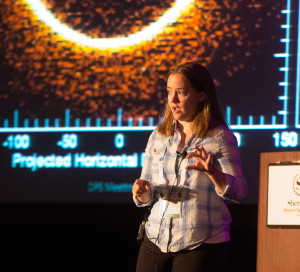
What we find here is a debris disk that is non-circular, its shape evidently explained by the presence, well outside the disk, of HD 106906b, whose orbit is elliptical. Observations through the Gemini Planet Imager, the Hubble Space Telescope and ESO’s SPHERE (Spectro-Polarimetric High-contrast Exoplanet REsearch instrument) show that we are viewing the disk nearly edge-on. The inner region appears cleared of small dust grains.
Working with these observations, a team led by Erika Nesvold, a postdoctoral fellow at the Carnegie Institution for Science, used a software tool she created called Superparticle-Method Algorithm for Collisions in Kuiper belts and debris disks (SMACK) to model the planet’s orbital path and assess its effects on the circumstellar disk.
Image: Erika Nesvold, creator of the software that made possible the new analysis of HD 106906b.
The disk, an analog of our own Kuiper Belt, is much closer to the star on one side than on the other, producing a stronger infrared signature on the warmer side. The model accurately reproduces the shape of the disk as a result of the perturbations caused by this distant planet. The team’s analysis shows that the planet must have formed outside the disk; otherwise, the disk would have been perturbed in an entirely different manner. From the paper:
Constraining the orbit of HD 106906b could have implications for its formation scenario. Prior to the publication of resolved images of the disk, it was suggested (using N-body simulations) that the companion formed interior to the disk and was scattered onto a highly eccentric orbit (Jílková & Portegies Zwart 2015). This study concluded that the disk can survive perturbations by a companion with an apocenter distance of 650 au and a pericenter distance interior to the disk if the companion’s inclination is ? 10°. However, this resulted in a significantly vertically perturbed disk by 10 Myr, regardless of the companion’s inclination. Our simulations indicate that a companion with an orbit completely exterior to the disk can reproduce the observed asymmetries without vertically extending the disk, supporting the scenario in which the companion formed in situ.
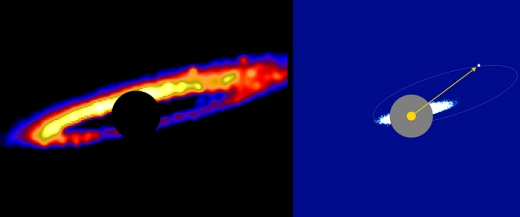
Image: Two images of the HD 106906 stellar system created by Erika Nesvold and her team’s simulation. The left panel shows a zoomed-in image of the ring of leftover rocky and icy planet-forming material that is rotating around the star. (The star is masked by the black circle.) The different hues represent gradients of brightness in the disk material. (Yellow is the brightest and blue the dimmest.). The right panel shows a farther-out view of the simulated system. The star is represented by the yellow circle with an arrow pointing to the exoplanet, HD 106906b. Nesvold’s team demonstrated that the exoplanet is shaping the structure of the debris disk, which is shown by the white and blue dots encircling the star. Credit: Erika Nesvold/Carnegie Institution for Science.
SMACK is able to re-create the shape of the disk without the addition of any planets within the disk itself, although the question of possible planets there remains open. The paper acknowledges that while HD 106906b can account for the disk’s shape, there are alternative mechanisms, including a planet within the debris disk, that could also force its eccentricity. Tightening up the parameters of HD 106906b’s orbit should help to resolve the question.
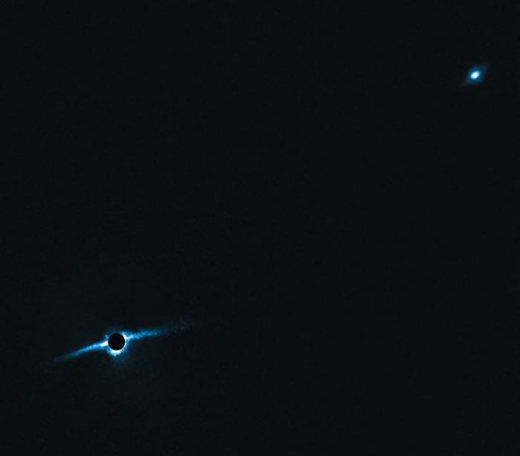
Image: This is an actual observation of HD 106906 taken by the European Southern Observatory’s planet-finding tool SPHERE. The star is blacked out by a circle (which masks its glare from blinding the instrument) and the debris disk can be seen in the lower left. In the upper right is the exoplanet, 106906b. The simulation created by Erika Nesvold and her team accurately recreated the observed characteristics of the disk: the disk is brighter on its eastern (left) side, and oriented about 20 degrees clockwise from the planet’s position on the sky. Credit: ESO and A.M. Lagrange of Université Grenoble Alpes.
Modeling tools like SMACK are going to be turned to other young system disks as we work to understand planetary evolution. After all, we’re seeing the process here in its infancy. “In our solar system, we’ve had billions of years of evolution,” said Michael Fitzgerald, UCLA associate professor of physics and astronomy, and a co-author on the study. “We’re seeing this young system revealed to us before it has had a chance to dynamically mature.”
The paper points out that previously undetected planets may be investigated by modeling the asymmetries in such disks. We do know that systems like this, with a large, exterior perturber of some kind, are not uncommon. Some 25 percent of known debris disks exist, for example, in binary or triple star systems. Understanding disk perturbations, whether they are caused by planets within the disk or outside of it, may point us toward the worlds that cause them.
The paper is Nesvold, Naoz & Fitzgerald, “HD 106906: A Case Study for External Perturbations of a Debris Disk,” Astrophysical Journal Letters Vol. 837, No. 1 (1 March 2017). Abstract / preprint.

Titan: Nitrogen Bubbles and ‘Magic Islands’
With Cassini now in the final stages of its mission, we can look forward to just one more close flyby of Titan, the 127th targeted encounter, on April 22. ‘Targeted’ means that Cassini has to use its thrusters to position itself optimally for the flyby. The first of the images below, by contrast, comes from a ‘non-targeted’ flyby, one of several anticipated for 2017.
The close pass will give researchers a chance to probe the moon’s northern seas one last time, which may prove useful in the investigation of the transient features some have dubbed ‘magic islands.’ Even as these studies proceed, Cassini will also be using the Titan flyby to alter its course enroute to the series of plunges through the gap between Saturn and its innermost rings now being called the Cassini Grand Finale. The spacecraft will plunge into Saturn’s atmosphere on September 15.
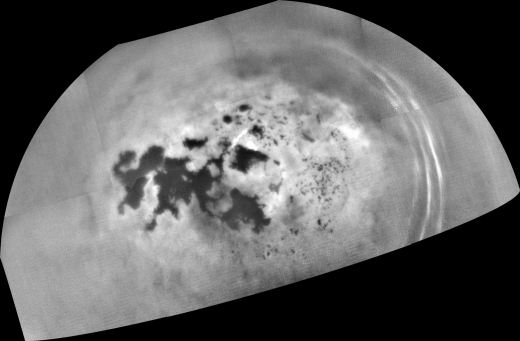
Image: As it sped away from a relatively distant encounter with Titan on Feb. 17, 2017, NASA’s Cassini spacecraft captured this mosaic view of the moon’s northern lakes and seas. Cassini’s viewing angle over Kraken Mare and Ligeia Mare was better during this flyby than previous encounters, providing increased contrast for viewing these seas. Because the spacecraft is peering through less of Titan’s haze toward Kraken and Ligeia, more details on their shorelines are visible, compared to earlier maps. Credit: NASA/JPL-Caltech/Space Science Institute.
But back to those ‘magic islands.’ Several previous Cassini flybys of Titan have revealed the radar signature of small areas on the seas that have appeared and then disappeared. In one instance, the feature re-emerged in subsequent imagery. Have a look at Ligeia Mare in the image below. With a total area of about 130,000 kilometers, this huge Titan lake is 50 percent larger than Lake Superior. The Cassini flyby on April 22 will re-observe this area. Similar transient features have been found on Kraken Mare, the largest of Titan’s seas. In both cases, we’re learning that Titan’s seas are more active places than originally thought.
The April 22 observations may help us to distinguish between floating or suspended solids, waves or bubbles as the culprit for the ‘magic islands,’ assuming that Cassini finds the phenomenon again. And if bubbles seem an unlikely cause, consider a new paper in the journal Icarus, which gives us an interesting look into how nitrogen behaves as it interacts with methane and ethane in conditions like those on Titan’s surface.
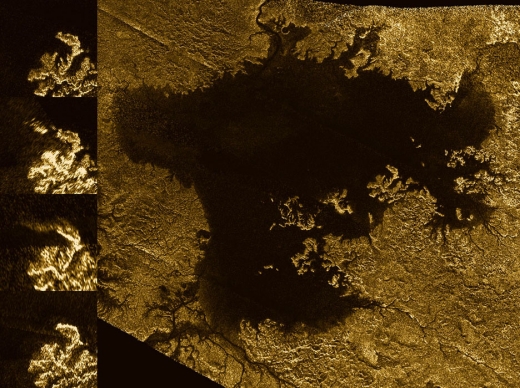
Image: These images from the radar instrument aboard NASA’s Cassini spacecraft show the evolution of a transient feature in the large hydrocarbon sea named Ligeia Mare on Saturn’s moon Titan. Analysis by Cassini scientists indicates that the bright features, informally known as the “magic island,” are a phenomenon that changes over time. They conclude that the brightening is due to either waves, solids at or beneath the surface or bubbles, with waves thought to be the most likely explanation. They think tides, sea level and seafloor changes are unlikely to be responsible for the brightening. The images in the column at left show the same region of Ligeia Mare as seen by Cassini’s radar during flybys in (from top to bottom) 2007, 2013, 2014 and 2015. The bottom image was acquired by Cassini on Jan. 11, 2015, and adds another snapshot in time as Cassini continues to monitor the ephemeral feature. The feature is apparent in the images from 2013 and 2014, but it is not present in other images of the region. Credit: NASA/JPL-Caltech/ASI/Cornell.
Through simulations of Titan’s surface conditions, JPL researchers have learned that a great deal of nitrogen can be dissolved in the cold liquid methane that rains out of Titan’s skies and flows through its rivers and lakes to the seas. This JPL news release likens the nitrogen release to the fizz that happens when you open a bottle of carbonated soda. The nitrogen bubbles would vary with the composition of the moon’s lakes and seas, depending on the concentration of ethane vs. methane, as JPL’s Michael Malaska, who led the study, explains:
“Our experiments showed that when methane-rich liquids mix with ethane-rich ones — for example from a heavy rain, or when runoff from a methane river mixes into an ethane-rich lake — the nitrogen is less able to stay in solution.”
This release of nitrogen could be a widespread phenomenon on Titan, and one that could also mark changes in season as methane seas warm and cool during the year. So the possibility exists that the ‘magic islands’ may be explained by fields of bubbles emerging from below. Nitrogen, like carbon dioxide being absorbed in Earth’s oceans, moves in both directions.
“In effect, it’s as though the lakes of Titan breathe nitrogen,” Malaska said. “As they cool, they can absorb more of the gas, ‘inhaling.’ And as they warm, the liquid’s capacity is reduced, so they ‘exhale.'”
The team’s simulations also show that when ethane ice forms — it appears on the bottom of a simulated Titan lake, rather than, like water on Earth, floating on the top — nitrogen can be released. So we have plentiful ways of coaxing bubbles out of liquid on Titan.
Whether or not these nitrogen bubbles are the cause of the ‘magic islands’ on Titan, we need to learn as much as we can about them. Proposals to send robotic vessels to float through Titan’s seas may have to be modified to account for them, for heat from the probe could cause bubbles to form around its various surfaces, possibly inducing problems in stability. The JPL work shows that even the slightest changes in temperature, air pressure or composition can cause the absorbed nitrogen to separate rapidly, a process we’ll have to anticipate.
The paper is Malaska et al., “Laboratory measurements of nitrogen dissolution in Titan lake fluids,” published online at Icarus 2 February 2017 (abstract).

JAXA Sail to Jupiter’s Trojan Asteroids
I like the way Jun Matsumoto approaches his work. A researcher with JAXA (Japan Aerospace Exploration Agency), Matsumoto is deeply involved in the design of the space sail that will pick up where Japan’s IKAROS left off. Launched in 2010, the latter was a square sail 14 meters to the side that demonstrated the feasibility of maneuvering a sail on interplanetary trajectories. JAXA has talked ever since about going to Jupiter, but the challenges are formidable, not the least of which is the question of generating enough power to operate over 5 AU from the Sun.
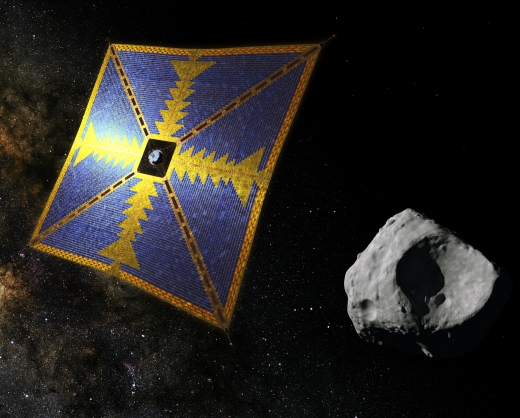
Image: A computer rendering shows what JAXA’s solar sail may look like as it approaches an asteroid. The probe is at the sail’s center. Credit: Japan Aerospace Exploration Agency.
But back for a moment to Matsumoto, who has the kind of long-term approach to his work that this site has long championed. I ran into him in an article in the Japan Times that ran last summer (thanks to James Jason Wentworth for the pointer). Matsumoto knows he is tied up in a project that will take decades, and he relishes the notion. Let me quote from the newspaper:
“I am currently the youngest JAXA staffer on this project. But by the time it is completed, I might no longer be part of the team due to retirement,” said Matsumoto, 27, who dreamed of becoming an astronaut as a child. “Wherever I go, people always talk about how to train young people to become the researchers of the next generation.
“Personally, I want to show children that there are adults who aim to explore places no human has ever gone.”

Image: JAXA workers and others attach electric wiring to a thin film that contains solar panels on July 13 in Sagamihara, Kanagawa Prefecture. Credit: Satoko Kawasaki / Japan Times.
It’s been too long since I’ve talked about this mission. The time frames here come from the necessary travel and exploration time, and the lengthy process of designing and building the spacecraft in the first place. The new JAXA sail, which has been in the planning pipeline since before IKAROS flew, will span 50 meters to the side, 2500 square meters that will contain the 30,000 solar panels — thin film solar cells attached to the entire surface of the sail membrane — necessary to operate at the 5.2 AU distance of Jupiter’s trojan asteroids.
Like IKAROS, the sail will use liquid crystal reflectivity control devices as a means of attitude control. But the new sail will also carry a high specific impulse ion engine for maneuvering among the trojan asteroid population. Here we’re at a key issue in the mission, for operating this far from the Sun, generating electrical power becomes increasingly difficult, and the craft will also need to perform numerous trajectory changes. Just as significant as the sail itself, then, will be the operational success of the new sail’s solar panels and ion engine.
The sail is to be made up of 10-micrometer-thick polyimide, with the payload attached to the center of the sail. Current plans are for launch in the early 2020s. The Jupiter trojans are a group of asteroids that share orbits with the giant planet, clustering in its L4 and L5 Lagrangian points. There should be no shortage of candidates, for the total number of Jupiter trojans greater than 1 kilometer in size is estimated at 106. The JAXA sail will perform both flyby and rendezvous operations, with a landing on the surface of a 20-30 km asteroid, operations there and, if all goes well, a sample return to the Earth in the 2050s.

Image: A slide from a JAXA presentation by Osamu Mori et al. on the new sail, called Direct Exploration of Jupiter Trojan Asteroid using Solar Power Sail, available online.
Last summer at a gymnasium in Sagamihara, Kanagawa Prefecture, a team of JAXA workers, academics and students unfolded a full-scale model of one of the sail’s four trapezoidal components before an audience of 250. As the article in the Japan Times points out, a mission lasting decades has to look not only to current researchers but the young scientists to whom its fate will be handed off, making Matsumoto’s long-term outlook germane not just to sail missions to Jupiter space but any long-haul ventures with decadal timeframes.

TRAPPIST-1h: Drawing on K2 Data
The data recently made available from Campaign 12 of K2 (the Kepler spacecraft’s two-reaction wheel mission) is already paying off in the form of information about the outermost planet in the TRAPPIST-1 system. Campaign 12 (described in Kepler Data on TRAPPIST-1 Coming Online) began on December 15 of 2016 and ran until March 4 of this year, though the spacecraft was in safe mode for a time, producing a 5-day data loss.
An international team including lead author Rodrigo Luger (University of Washington) and TRAPPIST-1 planet discoverer Michaël Gillon (Université de Liège) used the K2 data to constrain the period of TRAPPIST-1h, the outermost planet in this seven-planet system, which had only been observed to transit once before now. The team was also looking for additional planets (none were found) and, of course, examining resonances with the inner worlds.
The result: The orbital period of TRAPPIST-1h is found to be 18.764 days, a figure that fits into the pattern of resonance that the team’s theoretical work had predicted. TRAPPIST-1h is thus “…the seventh member of a complex chain, with three-body resonances linking every member.” The paper goes on to tell us that the planet has a radius of 0.715 R?, and an equilibrium temperature of 169 K, meaning it orbits at the snow line.
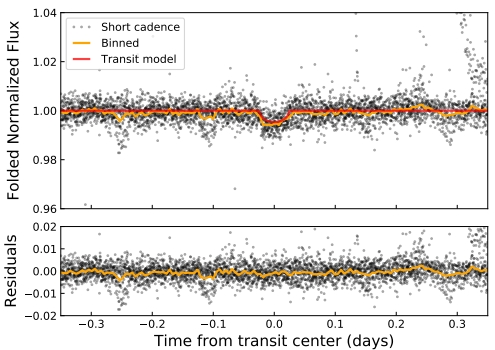
Image: Figure 3 from Luger et al. Caption: The short cadence data folded on the four transits of planet h after correcting for TTVs and subtracting a simultaneous transit of b and a near-simultaneous flare. Other transits of b ? g have not been removed and are visible in parts of the data. The data downbinned by a factor of 30 is shown as the orange line, and a transit model based solely on the Spitzer parameters is shown in red. The residuals (data minus this model) are shown at the bottom. Credit: Luger et al.
The paper notes that the stellar flux TRAPPIST-1h receives from its star is below what would be required to sustain liquid water under an atmosphere dominated by nitrogen, carbon dioxide and water (a hydrogen dominated atmosphere could theoretically make it possible). Nor is it on an orbit eccentric enough for tidal heating to warm the surface sufficiently. Nonetheless, tidal interactions play an important role in the evolution of the TRAPPIST-1 planets’ orbits. On the matter of formation and evolution, this was interesting:
The resonant structure of the system suggests that orbital migration may have played a role in its formation. Embedded in gaseous planet-forming disks, planets growing above ? 1 MMars create density perturbations that torque the planets’ orbits and trigger radial migration. One model for the origin of low-mass planets found very close to their stars proposes that Mars- to Earth-sized planetary embryos form far from their stars and migrate inward. The inner edge of the disk provides a migration barrier such that planets pile up into chains of mean motion resonances.
We can even extrapolate something about the speed of formation which, in turn, would have affected the compactness of the resulting system:
The TRAPPIST-1 system may thus represent a pristine surviving chain of mean motion resonances. Given that TRAPPIST-1’s planet-forming disk was likely low in mass and the planets themselves are low-mass, their migration was likely relatively slow. This may explain why TRAPPIST-1’s resonant chain is modestly less compact than chains in systems with more massive planets, which may have protected it from instability.
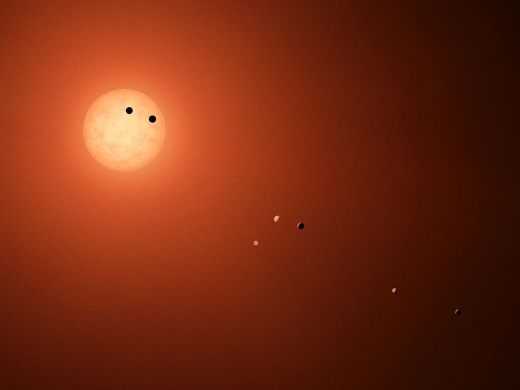
Image: An artist’s illustration of the seven TRAPPIST-1 planets. Sizes and relative positions are to scale. Credit: NASA/JPL-Caltech.
On the star TRAPPIST-1 itself, the researchers discovered it to be prone to star spots, making it possible to determine a rotational period of about 3.3 days, roughly comparable to nearby late M-dwarfs. The paper suggests an age in the range of 3 to 8 billion years. And note this re flare activity:
The presence of star spots and infrequent weak optical flares (0.38 d?1) for peak fluxes above 1% of the continuum, 30 times less frequent than active M6-M9 dwarfs are consistent with a low-activity M8 star, also arguing in favor of a relatively old system.
I notice that an energetic flare occurred at the end of the K2 campaign, and the authors promise that a full model of flare activity will be offered in an upcoming paper. This is useful information as we investigate questions of habitability among the inner worlds, for flares can damage atmospheres and have other adverse consequences for life.
It’s fascinating to consider how work like this develops from a damaged spacecraft. The paper points out that because of its two failed reaction wheels, the Kepler spacecraft’s rolling motion (created by imbalances in torque) induces strong instrumental effects, which lead to an increase of between 3 and 5 times in photometric noise compared to the original mission. The paper explains how removing these instrumental effects is done, but I continue to marvel at the fact that Kepler is still producing good science despite its serious internal problems.
The paper is Luger et al., “A terrestrial-sized exoplanet at the snow line of TRAPPIST-1,” submitted to Nature Astronomy (preprint).


